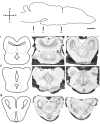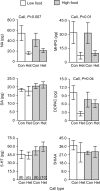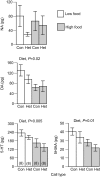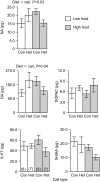Monoaminergic integration of diet and social signals in the brains of juvenile spadefoot toads
- PMID: 28659306
- PMCID: PMC5612016
- DOI: 10.1242/jeb.159954
Monoaminergic integration of diet and social signals in the brains of juvenile spadefoot toads
Abstract
Social behavior often includes the production of species-specific signals (e.g. mating calls or visual displays) that evoke context-dependent behavioral responses from conspecifics. Monoamines are important neuromodulators that have been implicated in context-dependent social behavior, yet we know little about the development of monoaminergic systems and whether they mediate the effects of early life experiences on adult behavior. We examined the effects of diet and social signals on monoamines early in development in the plains spadefoot toad (Spea bombifrons), a species in which diet affects the developmental emergence of species recognition and body condition affects the expression of adult mating preferences. To do so, we manipulated the diet of juveniles for 6 weeks following metamorphosis and collected their brains 40 min following the presentation of either a conspecific or a heterospecific call. We measured levels of monoamines and their metabolites using high pressure liquid chromatography from tissue punches of the auditory midbrain (i.e. torus semicircularis), hypothalamus and preoptic area. We found that call type affected dopamine and noradrenaline signaling in the auditory midbrain and that diet affected dopamine and serotonin in the hypothalamus. In the preoptic area, we detected an interaction between diet and call type, indicating that diet modulates how the preoptic area integrates social information. Our results suggest that the responsiveness of monoamine systems varies across the brain and highlight preoptic dopamine and noradrenaline as candidates for mediating effects of early diet experience on later expression of social preferences.
Keywords: Anurans; Behavioral plasticity; Body condition; Monoamines; Social preferences; Species recognition.
© 2017. Published by The Company of Biologists Ltd.
Conflict of interest statement
Competing interestsThe authors declare no competing or financial interests.
Figures





Similar articles
-
Differential encoding of signals and preferences by noradrenaline in the anuran brain.J Exp Biol. 2020 Sep 21;223(Pt 18):jeb214148. doi: 10.1242/jeb.214148. J Exp Biol. 2020. PMID: 32647019 Free PMC article.
-
Social signals increase monoamine levels in the tegmentum of juvenile Mexican spadefoot toads (Spea multiplicata).J Comp Physiol A Neuroethol Sens Neural Behav Physiol. 2013 Aug;199(8):681-91. doi: 10.1007/s00359-013-0826-6. Epub 2013 May 17. J Comp Physiol A Neuroethol Sens Neural Behav Physiol. 2013. PMID: 23681220
-
Neurobiology of Female Mate Choice in Frogs: Auditory Filtering and Valuation.Integr Comp Biol. 2017 Oct 1;57(4):857-864. doi: 10.1093/icb/icx098. Integr Comp Biol. 2017. PMID: 29048536 Review.
-
Diet alters species recognition in juvenile toads.Biol Lett. 2013 Oct 2;9(5):20130599. doi: 10.1098/rsbl.2013.0599. Print 2013 Oct 23. Biol Lett. 2013. PMID: 24088562 Free PMC article.
-
The incentive salience of courtship vocalizations: hormone-mediated 'wanting' in the auditory system.Hear Res. 2013 Nov;305:19-30. doi: 10.1016/j.heares.2013.04.011. Epub 2013 May 7. Hear Res. 2013. PMID: 23665125 Review.
Cited by
-
Dopamine Modulation of Motor and Sensory Cortical Plasticity among Vertebrates.Integr Comp Biol. 2021 Jul 23;61(1):316-336. doi: 10.1093/icb/icab019. Integr Comp Biol. 2021. PMID: 33822047 Free PMC article. Review.
-
Differential encoding of signals and preferences by noradrenaline in the anuran brain.J Exp Biol. 2020 Sep 21;223(Pt 18):jeb214148. doi: 10.1242/jeb.214148. J Exp Biol. 2020. PMID: 32647019 Free PMC article.
-
The neuropeptide Pth2 dynamically senses others via mechanosensation.Nature. 2020 Dec;588(7839):653-657. doi: 10.1038/s41586-020-2988-z. Epub 2020 Dec 2. Nature. 2020. PMID: 33268890
-
Monoamine neurochemistry, behavior, and microhabitat contribute to male coquí frog modes: silent, territorial, and paternal.J Comp Physiol A Neuroethol Sens Neural Behav Physiol. 2025 May;211(3):293-309. doi: 10.1007/s00359-025-01732-x. Epub 2025 Feb 5. J Comp Physiol A Neuroethol Sens Neural Behav Physiol. 2025. PMID: 39909908
References
-
- Brzoska J. and Obert H.-J. (1980). Acoustic signals influence the hormone production of the testes in the grass frog. J. Comp. Physiol. 140, 25-29. 10.1007/BF00613744 - DOI
Publication types
MeSH terms
Substances
Grants and funding
LinkOut - more resources
Full Text Sources
Other Literature Sources
Miscellaneous

